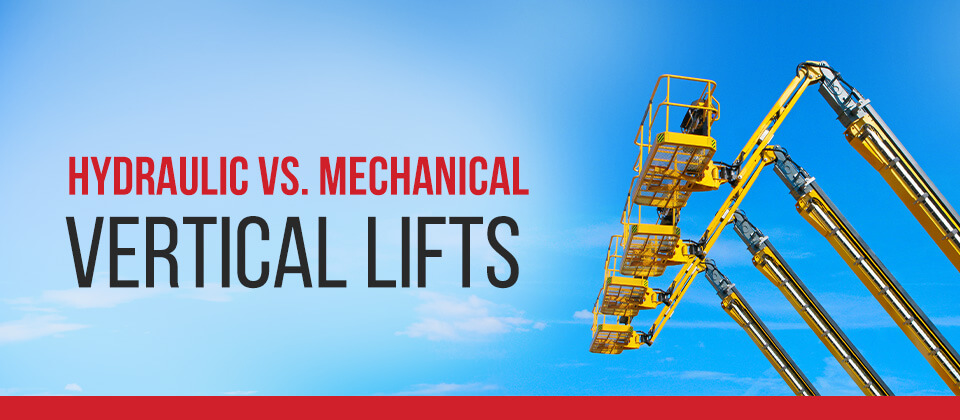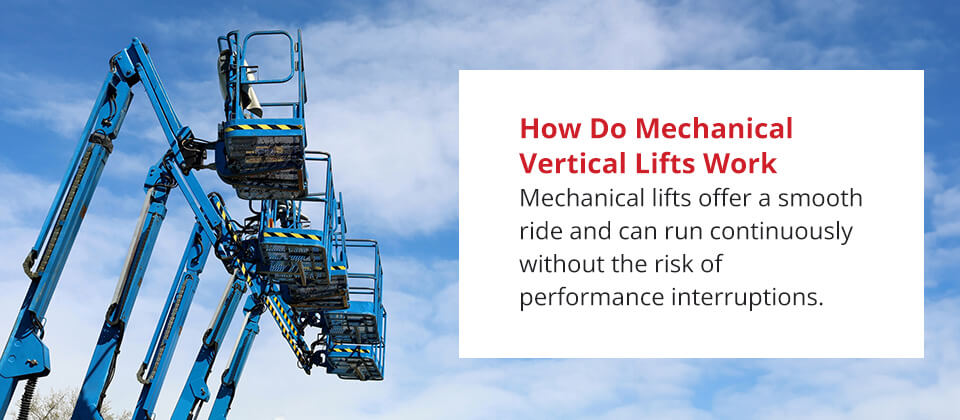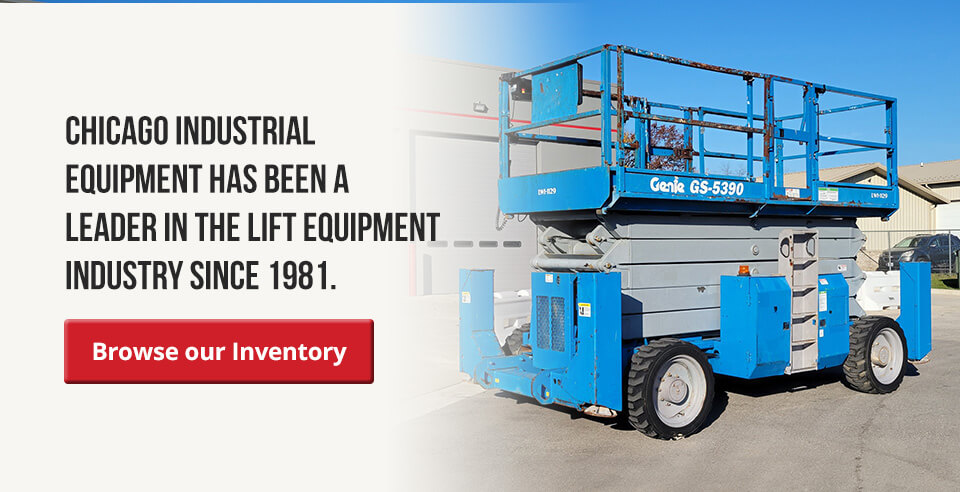Hydraulic vs. Mechanical Vertical Lifts

Material lifts, or vertical reciprocating conveyors (VRCs), make your operations more efficient, productive and safe. Use this guide to determine whether a hydraulic or mechanical vertical lift would best optimize your operations.
Hydraulic Vertical Lifts
Hydraulic lifts use fluid dynamics and pressure to raise and lower lift platforms. Explore how they work and some potential advantages and disadvantages.
How They Work
Five primary components assist with hydraulic vertical lift operation — fluid reservoirs, motors, pumps, pistons within cylinders and valves. The pump pushes the fluid, typically oil, into a cylinder. The cylinder pushes the piston up, and the piston pushes the lift car up. The valve regulates oil flow. When the valve is closed, oil flows from the reservoir to the cylinders. When it’s time to lower the lift, the valve opens up, allowing the fluid to flow back into the reservoir.
Hydraulic lifts are ideal for two-level lifting and come in two configurations:
- Cantilever: The lifting mechanism is situated under one side of the platform. When the lift extends to its full height, it looks like an upside-down “L.” Cantilever designs allow for “Z,” “C” and 90-degree loading and unloading patterns.
- Straddle: Straddle designs have two support beams on either side of the platform, and the lifting mechanism sits under the middle of the platform. This design allows for “Z” and “C” loading and unloading patterns.
Pros of Hydraulic Lifts
Hydraulic VRCs offer the following benefits:
- Two possible configurations: Straddle and cantilever designs allow for two and three loading and unloading options, respectively.
- More affordable upfront cost: Hydraulic lifts are less expensive to purchase and install.
- Effective for indoor and outdoor applications: You can use these lifts inside or outside, though you’ll want to consider the possibility of fluid spills before using hydraulic lifts outdoors.
- No wear and tear on a pulley system: Because fluid dynamics and pressure power them, hydraulic lifts do not put excess pressure on pulleys and gears.
- Great for small spaces: Hydraulic lifts may be the better option for operations with limited space.
Cons of Hydraulic Lifts
Consider the potential downsides of hydraulic lifts:
- More limited cycle use: Hydraulic lifts need time to rest between uses, making them unsuitable for high-speed applications. For example, you may be limited to 10 cycles per hour.
- More expensive to maintain: While they typically cost less to purchase and install, hydraulic lifts have higher maintenance expenses, raising their total lifetime cost. For example, you’ll need to empty and replace the hydraulic fluid according to the manufacturer’s instructions.
- Only effective for two-level configurations: Hydraulic lifts can only extend far enough to reach a second floor, balcony or mezzanine.
- Less environmentally friendly: The reliance on fluid makes hydraulic lifts less environmentally friendly than mechanical lifts.
- Less smooth ride: Hydraulic lifts may stop abruptly or offer a bumpier ride than mechanical lifts.
Mechanical Vertical Lifts
Heavy-duty gears and pulleys power mechanical VRCs. Here’s how they work and some pros and cons.
How They Work
Cables or chains lift and lower mechanical lifts. Mechanical lifts offer a smooth ride and can run continuously without the risk of performance interruptions. Like hydraulic lifts, mechanical vertical lifts are available in cantilever and straddle configurations. However, they also come in a four-post configuration, in which one post supports each corner of the lift, allowing for 360-degree access for loading and unloading.
Pros of Mechanical Lifts
These are some advantages of mechanical lifts:
- Unlimited cycle use: While hydraulic VRCs are limited to a certain number of cycles per hour, mechanical lifts can run continuously without experiencing efficiency issues.
- Additional 360-degree configuration: While hydraulic lifts come in only two configurations, mechanical lifts offer an additional four-post configuration.
- Able to reach more floors: Unlike hydraulic lifts, mechanical lifts can reach more than two levels.
- No risk of hazardous fluid spills: Hydraulic lift leaks can result in spilled fluid, which can be especially detrimental in outdoor or sterile environments.
- More environmentally friendly: Without fluids, mechanical lifts are more environmentally friendly.
- Less expensive to maintain: Mechanical lifts may have a higher upfront cost, but they also have fewer maintenance needs.
- Able to lift heavier payloads: Mechanical lifts can handle heavier loads while operating efficiently.
- Smooth ride: Mechanical lifts offer a smooth ride and are ideal for transporting fragile or delicate materials.
- Quiet operating sound: If noise reduction is a priority, mechanical lifts may be a better option than hydraulic lifts.
Cons of Mechanical Lifts
Possible disadvantages of mechanical VRCs include:
- Higher upfront costs: Mechanical lifts have a higher upfront cost than hydraulic lifts. However, their lifetime costs may even out due to the fewer maintenance needs. You can also work with an equipment marketplace that offers practical financing options.
- Not suitable for small spaces: Mechanical lifts may not be the best option if you have limited space.
- “Dead drop” possibility: Though highly uncommon, mechanical lift malfunctions can result in the equipment suddenly dropping to the floor. When hydraulic lifts malfunction, they’ll only drop as slowly as the fluid flows back to the reservoir.
Which Lift Is Right for Your Project?
The following factors can help determine the ideal lift for your project and industry:
- Consider your budget: Hydraulic lifts have lower upfront costs, but mechanical lifts have fewer maintenance needs. In both cases, prioritizing preventive maintenance can help you save on costs in the long term and may extend the life span of your equipment.
- Determine the number of hourly and daily cycles: Mechanical lifts are likely the better choice for high-speed or high-capacity operations. A hydraulic lift could suit your needs if you only run a few cycles per day.
- Evaluate lifting needs: If your space has more than two levels, you’ll need a mechanical lift.
- Think about your materials: Mechanical lifts have a higher payload capacity and offer a smoother ride for fragile items.
- Assess available space: Smaller spaces may require a hydraulic lift.
- Consider maintenance needs: Hydraulic lifts require more maintenance. Consider whether more intensive maintenance fits your budget and schedule.
- Determine the needs specific to your industry: Mechanical lifts may be the better option if noise control is a priority. Additionally, while hydraulic lifts work outdoors, you’ll want to consider the possibility of fluid spills and how they would impact the environment. Likewise, hydraulic lifts may not be ideal for sterile environments.
Explore Chicago Inventory Equipment’s New and Used Lift Equipment
When you’re ready to add lift equipment to your inventory, you can rely on Chicago Industrial Equipment.
Chicago Industrial Equipment has been a leader in the lift equipment industry since 1981. Our inventory is housed in our 10-acre yard or our 50,000-square-foot showroom in Rockdale, so you can view our available equipment in person. We also offer user-friendly financing solutions, including instant financing up to $100,000 with no financials required and deferred payments to align with your cash flow schedule.
Explore our lift equipment inventory, or contact us for a customized quote!



